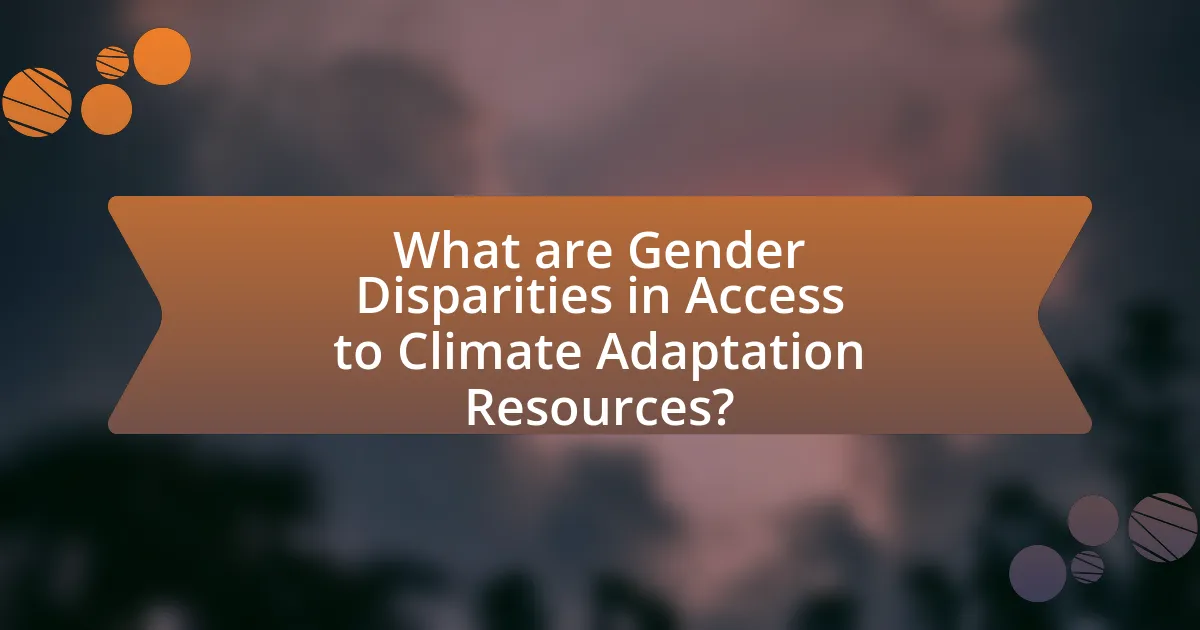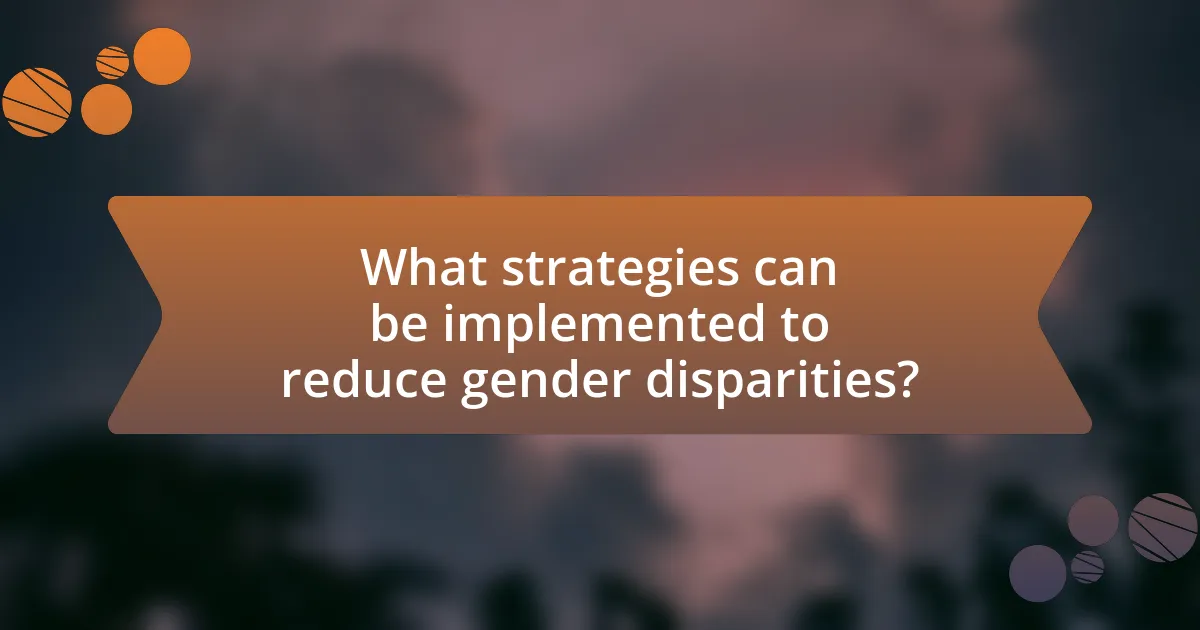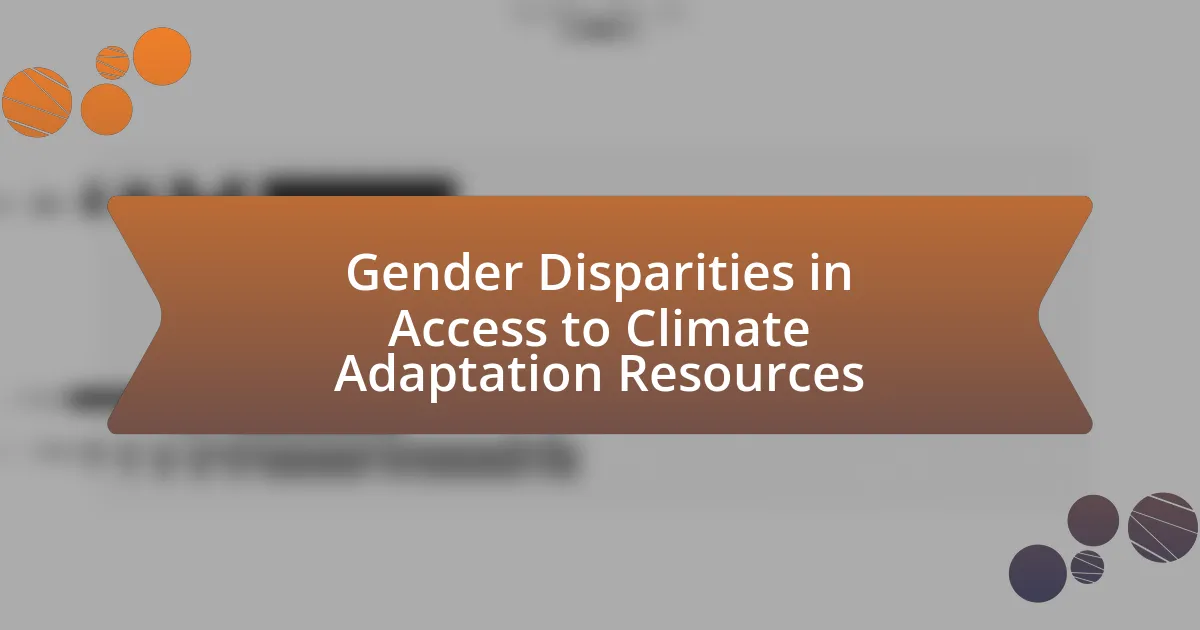Gender disparities in access to climate adaptation resources highlight the unequal opportunities faced by different genders, particularly women in developing regions. Women encounter significant barriers, including limited financial resources, decision-making power, and access to information, which hinder their ability to adapt to climate change. Factors such as socio-economic status, cultural norms, and institutional biases contribute to these disparities, exacerbating vulnerabilities and limiting women’s contributions to community resilience. Addressing these inequalities is crucial for enhancing climate adaptation efforts, as gender equity can lead to more effective and inclusive solutions, ultimately benefiting entire communities. The article explores the manifestations of these disparities, the barriers women face, and potential strategies for promoting gender equity in climate adaptation initiatives.

What are Gender Disparities in Access to Climate Adaptation Resources?
Gender disparities in access to climate adaptation resources refer to the unequal opportunities and resources available to different genders, particularly affecting women in developing regions. Women often face barriers such as limited access to financial resources, decision-making power, and information related to climate adaptation strategies. For instance, a study by the United Nations Development Programme highlights that women are disproportionately affected by climate change due to their roles in agriculture and resource management, yet they have less access to adaptation funding and technology. This disparity is further exacerbated by social norms and institutional biases that prioritize male perspectives in climate resilience planning.
How do gender disparities manifest in climate adaptation resource access?
Gender disparities in climate adaptation resource access manifest through unequal distribution of resources, decision-making power, and information access between genders. Women often face barriers such as limited financial resources, lack of ownership rights, and cultural norms that restrict their participation in climate-related decision-making processes. For instance, a study by the United Nations Development Programme found that women are less likely to receive funding for climate adaptation projects, with only 30% of climate finance going to projects that specifically address gender issues. This inequity hinders women’s ability to effectively adapt to climate change impacts, thereby exacerbating vulnerabilities and limiting their contributions to community resilience.
What factors contribute to these disparities?
Gender disparities in access to climate adaptation resources are primarily influenced by socio-economic status, cultural norms, and institutional barriers. Socio-economic status affects women’s ability to access financial resources and information necessary for adaptation, as women often have lower income levels and less property ownership compared to men. Cultural norms can restrict women’s participation in decision-making processes related to climate adaptation, limiting their access to resources. Institutional barriers, such as lack of gender-sensitive policies and inadequate representation of women in climate governance, further exacerbate these disparities. For instance, a study by the United Nations Development Programme highlights that women represent only 30% of decision-makers in climate-related sectors, which directly impacts their access to adaptation resources.
How do cultural norms influence access to resources?
Cultural norms significantly influence access to resources by shaping societal expectations and behaviors regarding gender roles. In many cultures, traditional norms dictate that men are the primary decision-makers and resource holders, which often marginalizes women’s access to essential resources such as land, finance, and information. For instance, a study by the Food and Agriculture Organization (FAO) found that women in developing countries are less likely to own land due to cultural beliefs that prioritize male ownership, limiting their ability to engage in climate adaptation practices. This disparity in access not only affects women’s economic empowerment but also hinders community resilience to climate change, as diverse perspectives and contributions are essential for effective adaptation strategies.
Why is it important to address gender disparities in climate adaptation?
Addressing gender disparities in climate adaptation is crucial because women often face greater vulnerabilities to climate impacts due to social, economic, and political inequalities. Research indicates that women are disproportionately affected by climate change, as they typically have less access to resources, information, and decision-making processes related to adaptation strategies. For instance, the United Nations Framework Convention on Climate Change (UNFCCC) highlights that women represent 70% of the world’s poor, making them more susceptible to climate-related disasters. By addressing these disparities, adaptation efforts can become more effective and equitable, ultimately leading to improved resilience for entire communities.
What are the potential impacts on communities?
Gender disparities in access to climate adaptation resources can lead to significant negative impacts on communities. These disparities often result in women and marginalized groups facing increased vulnerability to climate change effects, such as food insecurity, health risks, and economic instability. For instance, a study by the United Nations Development Programme highlights that women, who are often responsible for food production, may lack access to essential resources like land, credit, and technology, thereby diminishing their ability to adapt to climate changes. This lack of access can exacerbate poverty levels and hinder community resilience, ultimately affecting overall social cohesion and economic development.
How does gender equity enhance climate resilience?
Gender equity enhances climate resilience by ensuring that both men and women have equal access to resources, decision-making, and opportunities in climate adaptation efforts. When women participate equally in climate-related planning and implementation, their unique knowledge and experiences contribute to more effective and inclusive solutions. Research indicates that communities with higher gender equity are better equipped to respond to climate impacts, as women often play crucial roles in managing natural resources and implementing sustainable practices. For instance, a study by the World Bank found that closing gender gaps in agriculture could increase yields by 20-30%, thereby improving food security and resilience to climate change.

What are the key barriers to access for women in climate adaptation?
The key barriers to access for women in climate adaptation include limited access to financial resources, lack of decision-making power, inadequate representation in climate policy, and insufficient access to information and technology. Financial constraints hinder women’s ability to invest in adaptive measures, as studies show that women often have less access to credit and land ownership compared to men. Additionally, women’s limited participation in decision-making processes results in their needs and perspectives being overlooked in climate policies. Research indicates that women are underrepresented in leadership roles related to climate adaptation, which further exacerbates their marginalization. Furthermore, the lack of access to relevant information and technology restricts women’s ability to implement effective adaptation strategies, as they may not receive the necessary training or resources to adapt to changing climate conditions.
How do economic factors limit access to resources?
Economic factors limit access to resources by creating financial barriers that disproportionately affect marginalized groups, including women. For instance, limited income and lack of access to credit restrict the ability of these groups to invest in climate adaptation measures, such as sustainable agricultural practices or infrastructure improvements. According to the United Nations, women in developing countries are 14% less likely than men to own land, which directly impacts their access to resources necessary for adaptation. Additionally, economic instability can lead to reduced government funding for climate initiatives, further exacerbating resource scarcity for vulnerable populations.
What role does income inequality play?
Income inequality significantly impacts access to climate adaptation resources, particularly for marginalized groups, including women. Research indicates that lower-income individuals often lack the financial means to invest in necessary adaptations, such as resilient infrastructure or sustainable agricultural practices. For instance, a study by the United Nations Development Programme highlights that women, who disproportionately occupy lower-income brackets, face greater barriers in accessing resources needed to adapt to climate change. This disparity exacerbates vulnerabilities, as those with limited income are less able to recover from climate-related shocks, further entrenching gender inequalities in the context of climate adaptation.
How does access to financial resources differ by gender?
Access to financial resources differs by gender, with women often facing significant barriers compared to men. Research indicates that women are less likely to own assets, receive loans, or have access to credit, which limits their ability to invest in climate adaptation strategies. For instance, a study by the Global Gender Gap Report 2021 highlights that women globally have lower financial inclusion rates, with only 58% of women having access to financial services compared to 65% of men. This disparity in access to financial resources can hinder women’s capacity to respond effectively to climate change impacts, thereby exacerbating gender inequalities in adaptation efforts.
What social and political barriers exist?
Social and political barriers that exist in the context of gender disparities in access to climate adaptation resources include systemic discrimination, lack of representation, and inadequate policy frameworks. Systemic discrimination manifests through cultural norms and practices that prioritize male perspectives in decision-making processes, limiting women’s access to resources. Lack of representation is evident in the underrepresentation of women in leadership roles within climate governance, which hinders the incorporation of gender-sensitive approaches. Inadequate policy frameworks often fail to address the specific needs of women, resulting in unequal access to funding and support for climate adaptation initiatives. These barriers are supported by studies indicating that women are disproportionately affected by climate change due to existing gender inequalities, as highlighted in the United Nations Framework Convention on Climate Change reports.
How do legal frameworks affect women’s access to resources?
Legal frameworks significantly influence women’s access to resources by establishing the rights and protections that govern property ownership, inheritance, and access to financial services. For instance, in many countries, discriminatory laws limit women’s ability to own land or inherit property, which directly impacts their economic independence and access to resources necessary for climate adaptation. According to the World Bank, women in developing countries are 10% less likely than men to own land, which restricts their ability to invest in sustainable agricultural practices and adapt to climate change. Furthermore, legal barriers can hinder women’s access to credit and financial services, as seen in regions where laws require male co-signers for loans, thereby limiting women’s entrepreneurial opportunities and resource management capabilities.
What is the role of decision-making power in resource allocation?
Decision-making power plays a crucial role in resource allocation by determining who has the authority to distribute resources effectively. In the context of gender disparities in access to climate adaptation resources, decision-makers often influence the prioritization of funding and support, which can perpetuate inequalities. For instance, research indicates that women, who are disproportionately affected by climate change, frequently lack representation in decision-making bodies, leading to a misallocation of resources that does not address their specific needs. This imbalance can hinder effective climate adaptation strategies and exacerbate vulnerabilities among marginalized groups.

What strategies can be implemented to reduce gender disparities?
Implementing targeted education and training programs can significantly reduce gender disparities in access to climate adaptation resources. These programs should focus on equipping women with the necessary skills and knowledge to engage in climate resilience activities, such as sustainable agricultural practices and resource management. Research indicates that when women receive training, their participation in decision-making processes increases, leading to more equitable resource distribution. For instance, a study by the Food and Agriculture Organization found that women who received training in agricultural techniques improved their yields by 20-30%, demonstrating the effectiveness of education in empowering women and bridging gender gaps in resource access.
How can policy changes improve access to climate adaptation resources?
Policy changes can improve access to climate adaptation resources by ensuring equitable distribution and targeted support for vulnerable populations, particularly women. For instance, implementing gender-responsive policies can allocate funding specifically for women’s initiatives in climate adaptation, as women often face greater barriers to accessing resources. Research from the United Nations Development Programme indicates that when policies incorporate gender considerations, communities are more resilient to climate impacts, as women play crucial roles in resource management and decision-making. By prioritizing gender equity in climate policies, governments can enhance the effectiveness of adaptation strategies and ensure that all community members benefit from available resources.
What specific policies have proven effective in other regions?
Policies that have proven effective in addressing gender disparities in access to climate adaptation resources include gender-responsive budgeting, targeted capacity-building programs, and inclusive decision-making processes. For instance, in Rwanda, the government implemented gender-responsive budgeting, which allocated resources specifically for women’s access to climate adaptation initiatives, resulting in increased participation of women in agricultural adaptation strategies. Additionally, in Bangladesh, targeted capacity-building programs for women in rural areas have enhanced their skills and knowledge, enabling them to better access and utilize climate adaptation resources. Furthermore, inclusive decision-making processes in countries like Sweden have ensured that women’s voices are integrated into climate policy development, leading to more equitable resource distribution and improved outcomes for women in climate adaptation efforts.
How can local governance be strengthened to support women?
Local governance can be strengthened to support women by implementing policies that ensure equal representation and participation of women in decision-making processes. Research indicates that when women are included in local governance, it leads to more equitable resource allocation and improved community outcomes. For instance, a study by the World Bank found that women’s participation in local councils significantly enhances the effectiveness of climate adaptation strategies, as women often possess unique knowledge about local environmental challenges. Additionally, providing training and capacity-building programs for women can empower them to take on leadership roles, further solidifying their influence in governance.
What role do community-based initiatives play?
Community-based initiatives play a crucial role in addressing gender disparities in access to climate adaptation resources by empowering local populations to identify and implement solutions tailored to their specific needs. These initiatives foster collaboration among community members, enhance local knowledge, and promote inclusive decision-making processes, which are essential for effective climate adaptation. For instance, research by the International Institute for Environment and Development highlights that community-led projects often result in more equitable resource distribution and improved resilience to climate impacts, particularly for marginalized groups, including women. This evidence underscores the importance of community-based initiatives in bridging gender gaps in climate adaptation efforts.
How can grassroots movements empower women in climate adaptation?
Grassroots movements can empower women in climate adaptation by fostering community engagement and providing access to resources and decision-making processes. These movements often mobilize local women to participate in climate resilience initiatives, enabling them to share knowledge and strategies tailored to their specific needs. For instance, the Women’s Earth Alliance has demonstrated that when women are involved in grassroots climate initiatives, they can effectively advocate for sustainable practices and policies that address their unique challenges. Additionally, research shows that women-led community projects often result in improved environmental outcomes, highlighting the effectiveness of grassroots efforts in enhancing women’s roles in climate adaptation.
What examples of successful community programs exist?
Successful community programs addressing gender disparities in access to climate adaptation resources include the “Women’s Climate Centers” initiative in Kenya, which empowers women by providing training in sustainable agricultural practices and access to financial resources. This program has led to a 30% increase in crop yields among participating women farmers, demonstrating its effectiveness in enhancing food security and economic resilience. Another example is the “Gender and Climate Change” project in Bangladesh, which integrates gender considerations into climate adaptation strategies, resulting in improved access to resources for women and increased community resilience to climate impacts. These programs illustrate the positive outcomes of targeted interventions that address gender disparities in climate adaptation.
What best practices can organizations adopt to support gender equity?
Organizations can adopt several best practices to support gender equity, including implementing gender-sensitive policies, promoting equal pay, and ensuring diverse representation in leadership roles. Gender-sensitive policies help create an inclusive workplace by addressing specific needs and challenges faced by different genders. Promoting equal pay is essential, as research shows that women often earn less than men for the same work; for instance, the World Economic Forum reported a global gender pay gap of 16% in 2021. Ensuring diverse representation in leadership roles not only fosters a more equitable environment but also enhances decision-making processes, as diverse teams are proven to be more innovative and effective.
How can organizations ensure inclusive participation in climate initiatives?
Organizations can ensure inclusive participation in climate initiatives by actively engaging diverse stakeholders, particularly marginalized groups, in decision-making processes. This can be achieved through targeted outreach programs that educate and empower these communities, ensuring their voices are heard and considered in climate action plans. For instance, research indicates that involving women and local communities in climate adaptation strategies leads to more effective and equitable outcomes, as highlighted in the report “Gender and Climate Change: Framework for Analysis” by the United Nations Development Programme. This approach not only fosters inclusivity but also enhances the resilience of climate initiatives by integrating a broader range of perspectives and experiences.
What training and resources are essential for empowering women?
Essential training and resources for empowering women include education in leadership, financial literacy, and technical skills related to climate adaptation. These training programs equip women with the knowledge and confidence to participate in decision-making processes and manage resources effectively. For instance, the United Nations Development Programme highlights that women who receive training in sustainable agricultural practices can significantly improve their communities’ resilience to climate change. Access to financial resources, such as microloans and grants, further enables women to invest in sustainable practices and businesses, thereby enhancing their economic independence and influence.
